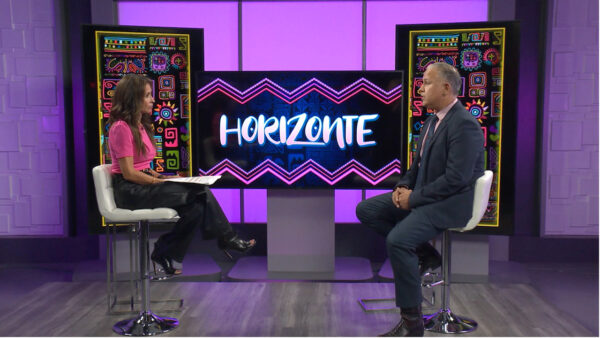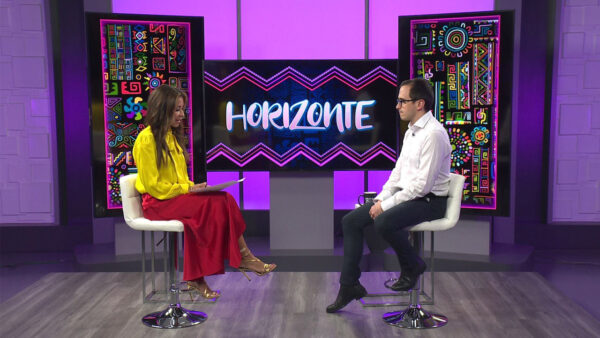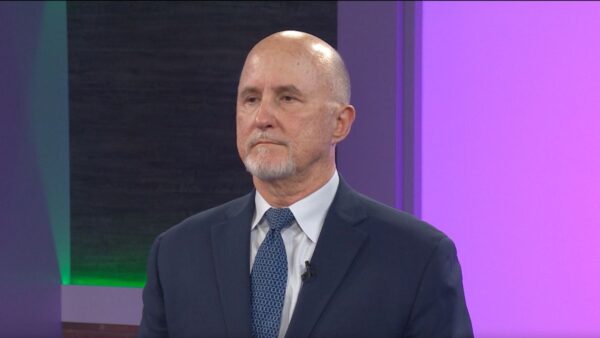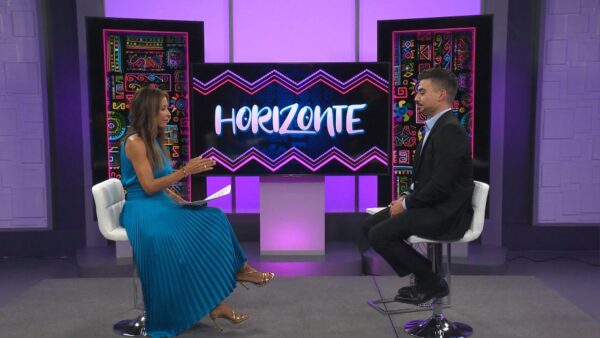Clemente Rico Rodriguez and Maurilio Rico Rodriguez both graduated from The Design School at ASU with degrees in landscape architecture. The twin brothers are the first in their family to go beyond elementary school. Clemente has been named the Jose Ronstadt Outstanding Student and received the honor at the ASU Hispanic Convocation. Clemente and Maurilio talk about their experience as first generation college graduates.
Richard Ruelas: Clemente Rico Rodriguez and Maurilio Rico Rodriguez both graduated from the Design School at ASU with degrees in landscape architecture. These twin brothers are first-generation college graduate, and they're here to tell their story. Let's welcome Clemente and his brother Maurilio. Welcome, we practiced in the green room, have I said your name correctly?
Maurilio Rico Rodriguez: Yes, correct. That's great.
Richard Ruelas: Twins born a few minutes apart, but it sounds like until, I mean, from some of the stuff I've seen from ASU, you guys weren't like close all your lives. So, you didn't have the twin bond going on.
Clemente Rico Rodriguez: Yeah, I mean, it was interesting because a lot of our friends would always say, where's your brother and even a lot of our professors would say that, you know, we would never -- we say, I think he's in school, he should be in school. But, you know, that's kind of how we grew up in our family. Our family's not -- we're not so close to each other, so we try to keep our things to each other.
Richard Ruelas: You're not in each other's business all the time.
Clemente Rico Rodriguez: Exactly, exactly. And so but it completely changed when we went to ASU because we were in the same program, meaning we had the same schedule, same classes, same professor, and also, just to make it easy on ourselves, we were roommates in the same dorm. So that we could share the entire room rather than just half and half, that's what happens in a lot of cases.
Richard Ruelas: The sibling rivalry was okay? There was no --
Maurilio Rico Rodriguez: No, everything was just better. Like he was saying, in middle school and high school, everybody -- each of us did our own thing. But in college, everything just came together in a way. But one of the things that we had between us is since we were in the same program, so this is what you can do, we criticized constructively, of course, but it worked perfectly for all of us.
Richard Ruelas: So you came over here about age 11. What was your childhood like? And what part of Mexico did you come from?
Clemente Rico Rodriguez: So, we were born in central Mexico in a small community. 400 people. Only 400 people lived there. The level of education, the highest level of education is elementary school there. So, you know, growing up there, we didn't ever have the idea that oh yeah, we were going to end up going into college and graduating and becoming professionals. The idea was turn 15, and then we'll do what most people do, in fact what everybody does there, just migrate to the United States to look for a job and then get married and then just -- that norm, that norm that our little community has and, in fact, a lot of places in Mexico. So, you know, we come from this poor family, so also a lot of the resources weren't there to kind of support education. So coming here, having the opportunity to move here. It was just something that I'm sure we never expected.
Richard Ruelas: Yeah, you come here not as a little kid but an 11-year-old. What were your first experiences like? What did you think of this place you had been brought to?
Maurilio Rico Rodriguez: For sure, it was definitely a culture shock for sure. We were always used to -- it was a really small community. You would have trees, you would have this green landscape, but as soon as we got here, it was nothing but parking lots. Everything was just concrete. So it was overwhelming at the beginning and most of the time we tried to stay home and, you know, just be within ourselves in a way. But I guess just over time, we just got used to it, we started meeting new people, friends, that kind of had the same similarities and over time we just got used to it for sure.
Richard Ruelas: But with your parents not having much education level, when did you get the idea that you could? When did college become something achievable possibly for you?
Maurilio Rico Rodriguez: One of the things is that our parents, they appreciate education and they know that for most of us, it's a way to overcome and have a better life in a way. So they know. But one of the things -- so that's one of the things that they made us do. We would always go to school, go to school. They didn't care what we would do, they didn't care which path we would choose but they just wanted us to be in school.
Richard Ruelas: I imagine because your father came here earlier, applied for residency and was able to get the family in with the papers, you probably had opportunities, I don't know if you had classmates that were maybe in different situations with their legalization that might have made a harder road for them.
Clemente Rico Rodriguez: Definitely. Where we come from, even where we got our education, we come from communities where there's high numbers of Hispanics, they're in the same position as we were or they didn't have the opportunity to be here legally and have the opportunity to go to college. So, you know, even we have a lot of family members who are in the same situation. So us moving forward, with this different path and kind of having family members staying back, in a way, it's kind of sad because personally I think we believe that we want to have something good for everyone. But that's kind of the way it is. But at the same time, we want to have -- once we have the responsibility right? So now that we have the opportunity to get an education, we feel like we have the responsibility to help, not just our family members, but also just individuals who are staying back because of legal issues.
Richard Ruelas: It also helps the community because your senior project that you worked on together, landscape structure, there's an element of social justice to it, talk about, whichever one of you wants to take the lead on it, the I-17 project you conceived.
Clemente Rico Rodriguez: So, this semester's project for our studio was focusing on working on a system, and I personally, we both -- we don't want to become designers where we just want to make something pretty. But we want to become designers who find problems and have solutions for their problems.
Richard Ruelas: So, we know 1-17 by south Phoenix. There's a lot of industrial area, and a lot of people living and going to school right up there, so this looks like it tries to clean the air as cars go by?
Clemente Rico Rodriguez: Exactly. So we know that everyone's going to use a car, and that's the reality. And instead of finding ways of getting rid of the car, why not find ways to kind of mitigate the problems the car causes? And so while we were doing our research, we found that titanium dioxide, it's a chemical compound that actually reacts with car emissions, and the reactions of those car emissions creates nitrates and water molecules which become actually food for plants. And so at the same time, we wanted to find a way to not just reduce the air pollution but also have a steady structure over the freeway.
Richard Ruelas: Is it pie in the sky stuff? How expensive would this be, is it realistic? Can we get a kick starter together?
Maurilio Rico Rodriguez: Maybe not, maybe not. But the idea of our concept was just to make people start thinking about those kind of -- we tend to ignore more those kind of problems that we have here in the valley, you know. We don't really think about people who live near freeways, maybe the noise is a problem but there's more than that. There are things that we don't see, but they're even more harmful to the people that live there, especially students. There are schools that are near freeways and with the research that we did we found it's just so bad for them, especially for children. So this is a way to start making people think like maybe we should start doing something, you know.
Richard Ruelas: You set a very high reimagining of what a freeway could look like and maybe somewhere in the middle there's a practical use for it. Because this is -- are there ways -- I mean, talk about the spaces you want to produce in the city, things that are achievable that sort of have that social justice element to it. What can we do as a city?
Clemente Rico Rodriguez: I think what has to start is the conversation, what do we need to do? I think one of the challenges with, for example, the landscape architecture profession is that we're staying in a level where we're not really producing new things. And because there's a lot of environmental impacts happening because of, you know, industrial components of urbanization aspects, so what happens, what we need to start thinking about is how do we work with those changes and how do we reduce the impacts that the urbanization is having on the environment? Now, there are different -- several designers here in the valley and also around the world who are focusing on that, who try to make changes or too maintain or reduce the impacts from urbanization. One thing that has to happen, though, is this discourse about design, and I don't think it's the designer's job to make the entire space, but it's also having the communities because successful projects are the ones that are taken over by the community members. Those are truly successful projects.
Richard Ruelas: They adopt them themselves, make it their own.
Clemente Rico Rodriguez: Exactly, we need to educate the community.
Richard Ruelas: And we'll probably have you back, let's hope in the coming years as you start building projects in Arizona and California and Spain, wherever else you end up. Clemente, Maurilio, thank you both for joining us.
Maurilio Rico Rodriguez: Thank you.
Clemente Rico Rodriguez: Thank you so much.
Clemente Rico Rodriguez:Graduate, Design School at Arizona State University; Maurilio Rico Rodriguez:Graduate, Design School at Arizona State University;




















